|
==============================================================================
TOPIC: Pa. Audubon Wildlife Sanctuary RI
http://groups.google.com/group/entstrees/t/5cb6d64ca031d335?hl=en
==============================================================================
== 1 of 5 ==
Date: Fri, Dec 5 2008 5:17 pm
From: "George Fieo"
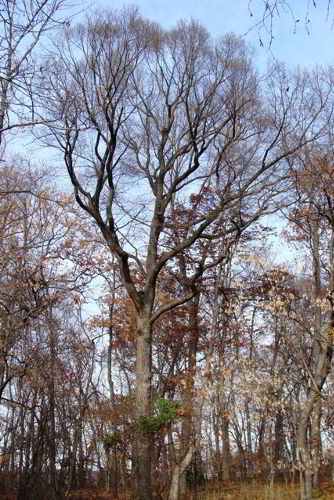
Black Gum |
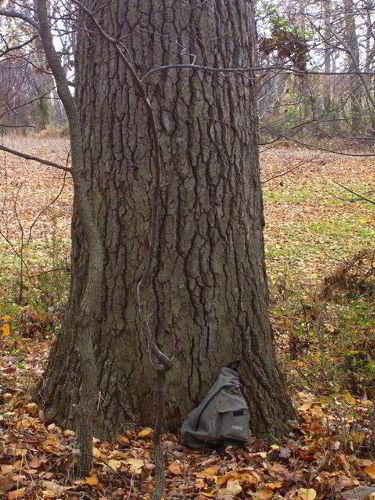
Black Gum |
ENTS,
Last week I finally got a clinometer and laser rangefinder. I had
some free
time today so I visited the Audubon Wildlife Sanctuary since it is
close to
home and looks like a good site to start a Rucker Index. There are
at least
20 native species here. The sanctuary consists of 175 acres
overlooking the
Perkiomen Creek and was once the home of John James Audubon. I have
been
wanting to get a height measurement for a Virginia pine here that
may make
Scott's Pa. Big Tree List. I believe the RI can go even higher. I
ran out
of time as I was just getting into the taller trees.
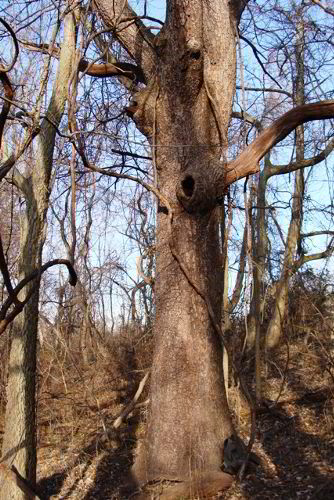 Black Walnut cbh 9' 2'
Black Walnut cbh 9' 2'
Here are the
numbers I
came up with.
Audubon Wildlife Sanctuary Rucker Index
Species CBH Height
Tulip poplar 7'2" 119.5
White ash 7'5" 115.1
Shagbark hickory 5'9" 113.9
Black gum N/A 108.0
Black oak 8'7" 105.5
White oak 10'4" 103.5
Hemlock 6'2" 101.5
Sugar maple 5'7" 101.3
Sycamore 12'2" 97.4
Red oak 7'7" 91.9
Rucker Index 105.8
I plan on returning to this site soon to measure the taller patch I
missed.
Thanks George.
== 2 of 5 ==
Date: Fri, Dec 5 2008 6:34 pm
From: "Edward Frank"
George,
Excellent start on your measuring career. Is this the John James
Audubon Center at Mill Grove, 1201 Pawlings Rd, Norristown, PA 19403
?
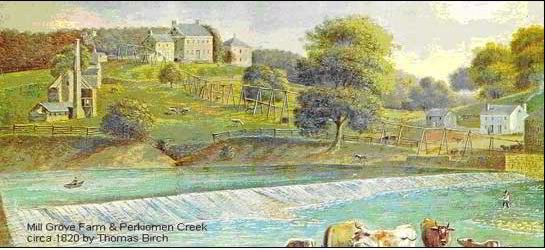
http://pa.audubon.org/centers_mill_grove.html
http://historicsites.montcopa.org/historicsites/cwp/view,A,3,Q,24466,historicsitesNav,%7C.asp
http://www.yellowpages.com/info-LMS73459730/Audubon-Sanctuary/maps
I would encourage you to not only measure the tall trees, but to try
and get measurements of as many different species of trees as
possible. The website says there have been over 400 species of
plants identified on the property, but I don't know how many of
those are trees and woody shrubs.
Ed
== 3 of 5 ==
Date: Fri, Dec 5 2008 8:27 pm
From: "George Fieo"
Ed,
Yes, this is the same site. It is located in Audubon. Norristown is
the
mailing address.
I did measure a few others but used the tallest for
the
RI. They are,
Virginia pine cbh-3'1" 76.9
Black cherry cbh-5'4" 83.6
American beech cbh-7'2" 90.5
Yellow birch cbh-5'7" 91.3
I'm sure I can get better heights for these trees as well. Some
trees I
have seen but not measured yet are,
Pignut hickory
Mockernut hickory ?
Slippery elm
Hackberry
Black walnut
Red maple
Chestnut oak
Sassafras
Dogwood
I will do return trips for understory shrubs and perennials.
George.
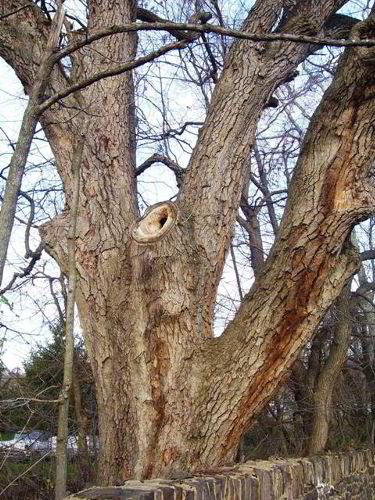
Black Gum at cemetary |
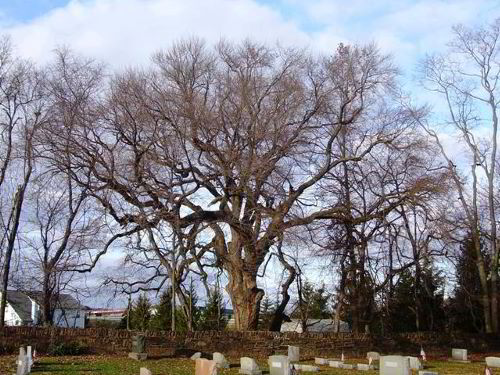
Black Gum at cemetary |
== 4 of 5 ==
Date: Fri, Dec 5 2008 8:44 pm
From: "Edward Frank"
George,
Several people in the group do nice descriptions of the perennials
and other plants, but most do not. There really isn't a good
definition of the difference between a woody shrub and a tree. Many
of the definitions out there divide them by a height criteria and
stem criteria. Here are a couple of definitions from Biology online:
Shrub: A woody plant less than 5 metres (approx. 15 feet) high,
either without a distinct main main stem, or with branches
persisting on the main main stem almost to its base. A low woody
perennial plant usually having several major branches.A woody plant
less than ten metres in height.
Tree: A woody plant at least 5 metres high, with a main stem the
lower part of which is usually unbranched.
These seem pretty arbitrary definitions when we often find
"shrub" species that grow to tens of feet high and have
large single stems. So when we measure them, they are lumped
together with the trees. That is my perspective anyway. Nice to have
you aboard.
It looks from the 1820 painting that there were not many trees left
standing in the farm in 1820. It would be neat to find one of the
trees predating this period, if any are still present. (especially
the nice big one in the front of the painting!
Ed Frank
== 5 of 5 ==
Date: Fri, Dec 5 2008 9:45 pm
From: "George Fieo"
Ed,
There is a large Sycamore about 20 yds from one of the smaller
houses. I'm
sure it predates the painting. I would guess it has a 17'+ cbh.
There are a
few other fat ones scattered about. Most of the largest trees mark
the
location of where some of these buildings once stood. All that is
left are
the foundations and a few chimneys. I'll bring my camera next time I
go
back.
George.
==============================================================================
TOPIC: Pa. Audubon Wildlife Sanctuary RI
http://groups.google.com/group/entstrees/t/5cb6d64ca031d335?hl=en
==============================================================================
== 1 of 5 ==
Date: Sun, Dec 14 2008 6:25 pm
From: "George Fieo"
Dale and Ed,
Today I completed the RI for the Audubon Wildlife Sanctuary. I have
also
attached some pictures of some note worthy trees and of what is left
of some
of the original buildings dating to the early 1800's.
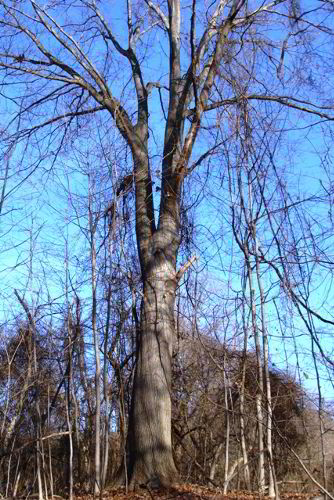
Red Oak 100.9 feet tall, cbh 11; 11" |
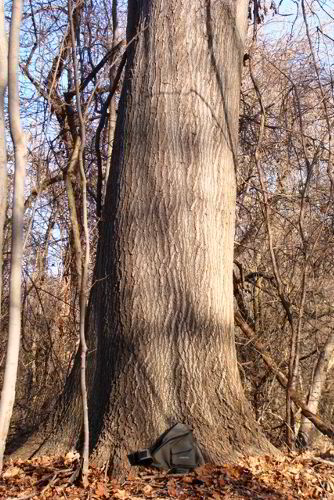
Red Oak 100.9 feet tall, cbh 11; 11" |
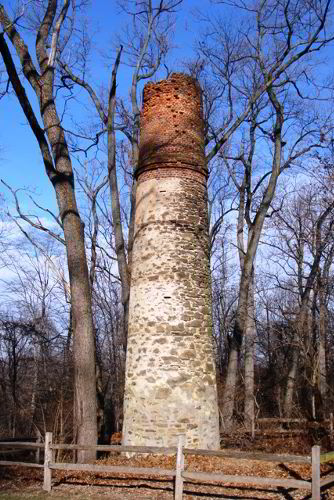 |
Audubon Wildlife Sanctuary Site Index
Species CBH Height
Tulip poplar 4'10" 124.2
Shagbark hickory 5'1" 121.5
White ash 7'5" 115.1
Pignut hickory 7'8" 108.3
Common hackberry 6'1" 108.2
Black oak 8'7" 105.5
Sycamore 5'4" 103.9
White oak 10'4" 103.5
Hemlock 6'2" 101.5
Sugar Maple 5'7" 101.3
Red oak 11'11" 100.9
Red maple 9'0" 99.3
Black gum 10'1" 92.7
Slippery elm 3'9" 92.2
Yellow birch 5'7" 91.3
American beech 7'2" 90.5
Black locust 4'9" 88.3
Black walnut 4'5" 86.4
Chestnut oak 5'1" 85.9
Black cherry 4'6" 85.6
Boxelder 2'11" 77.4
Virginia pine 3'1" 76.9
Sassafras 5'10" 72.6
Swamp white oak 11'6" 67.5
Audubon Wildlife Sanctuary RI
Species CBH Height
Tulip poplar 4'10" 124.2
Shagbark hickory 5'1" 121.5
White ash 7'5" 115.1
Pignut hickory 7'8" 108.3
Common hackberry 6'1" 108.2
Black oak 8'7" 105.5
Sycamore 5'4" 103.9
White oak 10'4" 103.5
Eastern hemlock 6'2" 101.5
Sugar maple 5'7" 101.3
Rucker Index 109.3
Here are a few other note worthy trees
Species CBH Height
White oak 12'3" 85.4
Sycamore 12'2" 97.4
Sycamore 15'3" 87.0
Black walnut 9'2" 86.3
Dale, I can't find any current stats but the Shagbark and Hackberry
may be
height contenders.
George.
== 2 of 5 ==
Date: Sun, Dec 14 2008 7:08 pm
From: "Edward Frank"
George,
Excellent. I a happy to see numbers being generated. Here is a
species profile of your data:
Audubon Wildlife Sanctuary, Norristown, PA
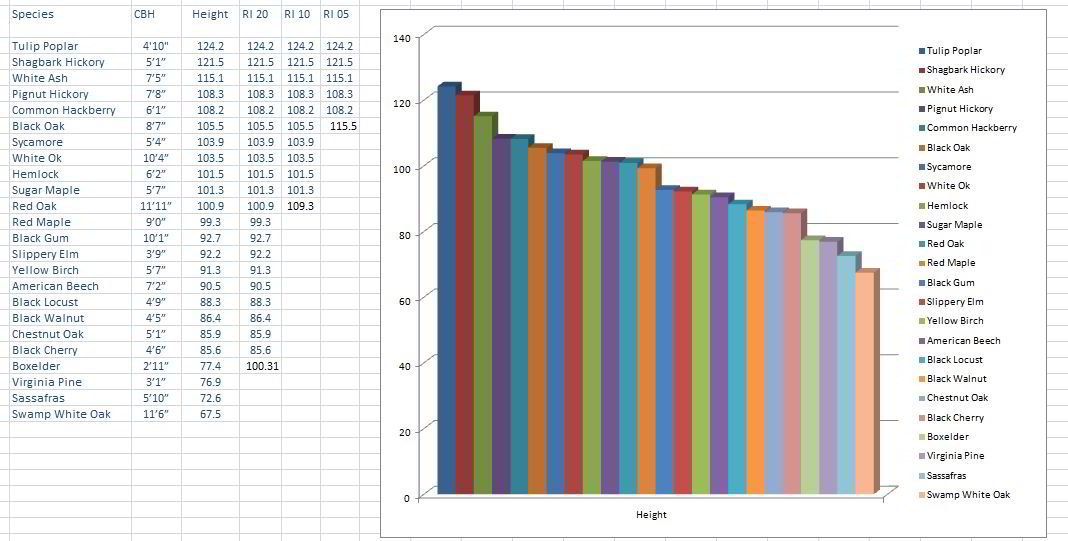
I have calculated Rucker Indexes for 5, 10, and 20 species.
RI05 = 115.5
RI10 = 109.3
RI20 = 100.31
Ed Frank
== 3 of 5 ==
Date: Sun, Dec 14 2008 7:40 pm
From: "George Fieo"
Dale and Ed,
Here are some pictures I forgot to attach of a Slippery elm, cbh
7'3" - h
88.4, that has some great root flare.
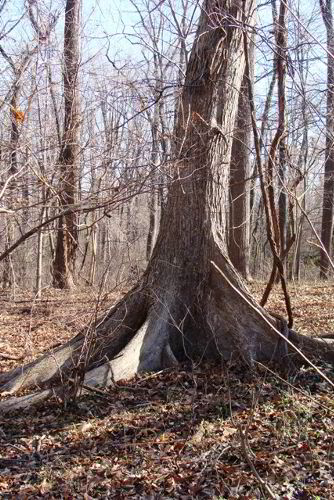
George.
== 4 of 5 ==
Date: Sun, Dec 14 2008 8:07 pm
From: "George Fieo"
Ed,
Very cool seeing it as a graph. I have a few other sites I'd like to
do
when I find the time.
Thanks, George.
== 5 of 5 ==
Date: Sun, Dec 14 2008 8:38 pm
From: "Edward Frank"
George,
There are a number of other determinations that can be made with a
dataset like this.
ENTS Points
[(girth x girth x height)/100]
Audubon Wildlife Sanctuary, Norristown, PA
Species CBH Height ENTS Points
Sycamore 15.3 87 2036.6
Sycamore 12.2 97.4 1449.7
Red Oak 11.9 100.9 1428.8
White Oak 12.3 85.4 1292.0
White Oak 10.3 103.5 1098.0
Black Gum 10.1 92.7 945.6
Swamp White Oak 11.5 67.5 892.7
Red Maple 9 99.3 804.3
Black Oak 8.6 105.5 780.3
Black Walnut 9.2 86.3 730.4
Pignut Hickory 7.7 108.3 642.1
White Ash 7.4 115.1 630.3
American Beech 7.2 90.5 469.2
Common Hackberry 6.1 108.2 402.6
Hemlock 6.2 101.5 390.2
Sugar Maple 5.7 101.3 329.1
Shagbark Hickory 5.1 121.5 316.0
Sycamore 5.3 103.9 291.9
Tulip Poplar 4.83 124.2 289.7
Yellow Birch 5.6 91.3 286.3
Sassafras 5.8 72.6 244.2
Chestnut Oak 5.1 85.9 223.4
Black Locust 4.8 88.3 203.4
Black Cherry 4.5 85.6 173.3
Black Walnut 4.4 86.4 167.3
Slippery Elm 3.8 92.2 133.1
Virginia Pine 3.1 76.9 73.9
Box elder 2.9 77.4 65.1
Tree Dimension Index (TDI)
A more complicated calculation is the TDI for all of your specimens.
This is equal to the
(girth of your specimen/ girth maximum for the species) + (height of
your specimen/ height maximum for the species)
For one species - Bitternut Hickory - your listed girth is greater
than the maximum on the ENTS list. But it is simply an oversight as
there are fatter bitternuts out there. So your TDI for bitternut
will go down when it is corrected. The second example on your list
is - Hackberry - the height of your hackberry is greater than any
specimen on the ENTS list so far. Again that is likely to be a
result of limited measurement of the species.
Audubon Wildlife Sanctuary, Norristown, PA
Species CBH Height ENTS Points Girth Max Height Max TDI Girth TDI
Height TDI
Pignut Hickory 7.7 108.3 642.1 7.5 140.3 1.03 0.77
179.86
Black Gum 10.1 92.7 945.6 12.9 124.1 0.78 0.75
152.99
Common Hackberry 6.1 108.2 402.6 12.9 105.8 0.47 1.02
149.56
Swamp White Oak 11.5 67.5 892.7 13.3 119.2 0.86 0.57
143.09
White Ash 7.4 115.1 630.3 16 153.4 0.46 0.75
121.28
Red Oak 11.9 100.9 1428.8 21.5 153.1 0.55 0.66
121.25
White Oak 10.3 103.5 1098.0 20.8 147.1 0.50 0.70
119.88
Shagbark Hickory 5.1 121.5 316.0 13 154.4 0.39 0.79
117.92
White Oak 12.3 85.4 1292.0 20.8 147.1 0.59 0.58
117.19
Yellow Birch 5.6 91.3 286.3 14.7 116.7 0.38 0.78
116.33
Black Oak 8.6 105.5 780.3 20.6 143.4 0.42 0.74
115.32
Red Maple 9 99.3 804.3 21.8 142.6 0.41 0.70
110.92
Sycamore 15.3 87 2036.6 27.2 162.2 0.56 0.54
109.89
Black Walnut 9.2 86.3 730.4 18.9 144.6 0.49 0.60
108.36
Virginia Pine 3.1 76.9 73.9 7.4 121.9 0.42 0.63
104.98
Sycamore 12.2 97.4 1449.7 27.2 162.2 0.45 0.60
104.90
American Beech 7.2 90.5 469.2 17.3 143.2 0.42 0.63
104.82
Sugar Maple 5.7 101.3 329.1 16.5 144.2 0.35 0.70
104.80
Box elder 2.9 77.4 65.1 10.6 101.3 0.27 0.76
103.77
Slippery Elm 3.8 92.2 133.1 11.2 141.2 0.34 0.65
99.23
Black Locust 4.8 88.3 203.4 10.8 171.8 0.44 0.51
95.84
Chestnut Oak 5.1 85.9 223.4 15.1 143.9 0.34 0.60
93.47
Hemlock 6.2 101.5 390.2 18.8 173.1 0.33 0.59
91.62
Sassafras 5.8 72.6 244.2 16.3 130.6 0.36 0.56
91.17
Tulip Poplar 4.83 124.2 289.7 27 180 0.18 0.69
86.89
Black Cherry 4.5 85.6 173.3 17.3 140.7 0.26 0.61
86.85
Sycamore 5.3 103.9 291.9 27.2 162.2 0.19 0.64
83.54
Black Walnut 4.4 86.4 167.3 18.9 144.6 0.23 0.60
83.03
"The most beautiful thing we can experience is the mysterious.
It is the source of all true art and all science." - Albert Einstein
== 4 of 5 ==
Date: Sun, Dec 14 2008 9:37 pm
From: "Edward Frank"
George,
I was not working with the most updated copy of the list. it is
being maintained by Jess Riddle, and some of the other numbers may
be off a little also, but it is still a useful demonstration. I know
Scott Wade has a fatter black gum at 15 feet girth, that was not on
my list either.
Corrected TDI values
Black Gum 10.1 92.7 945.6 15 124.1 0.67 0.75 142.03
Pignut Hickory 7.7 108.3 642.1 11.2 163.4 0.69 0.66 135.03
Common Hackberry 6.1 108.2 402.6 12.9 117.1 0.47 0.92 139.69
Ed
== 5 of 5 ==
Date: Mon, Dec 15 2008 1:00 am
From: James Parton
George,
Nice trip report. I can't ever remember seeing a Black Walnut that
big!
James Parton
== 5 of 5 ==
Date: Mon, Dec 15 2008 11:38 am
From: "Edward Frank"
George and ENTS,
Here is a better/different version of your tree species profile
graph.
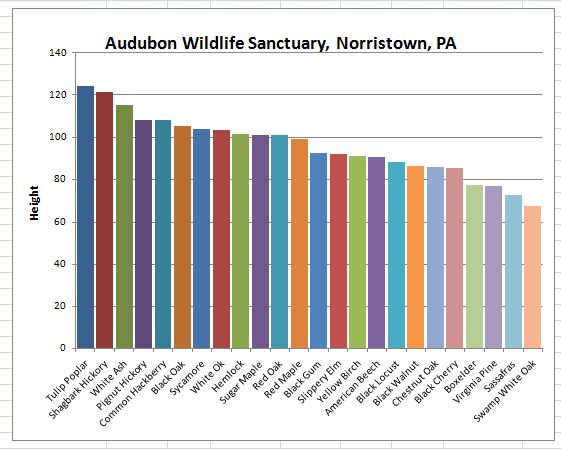
|